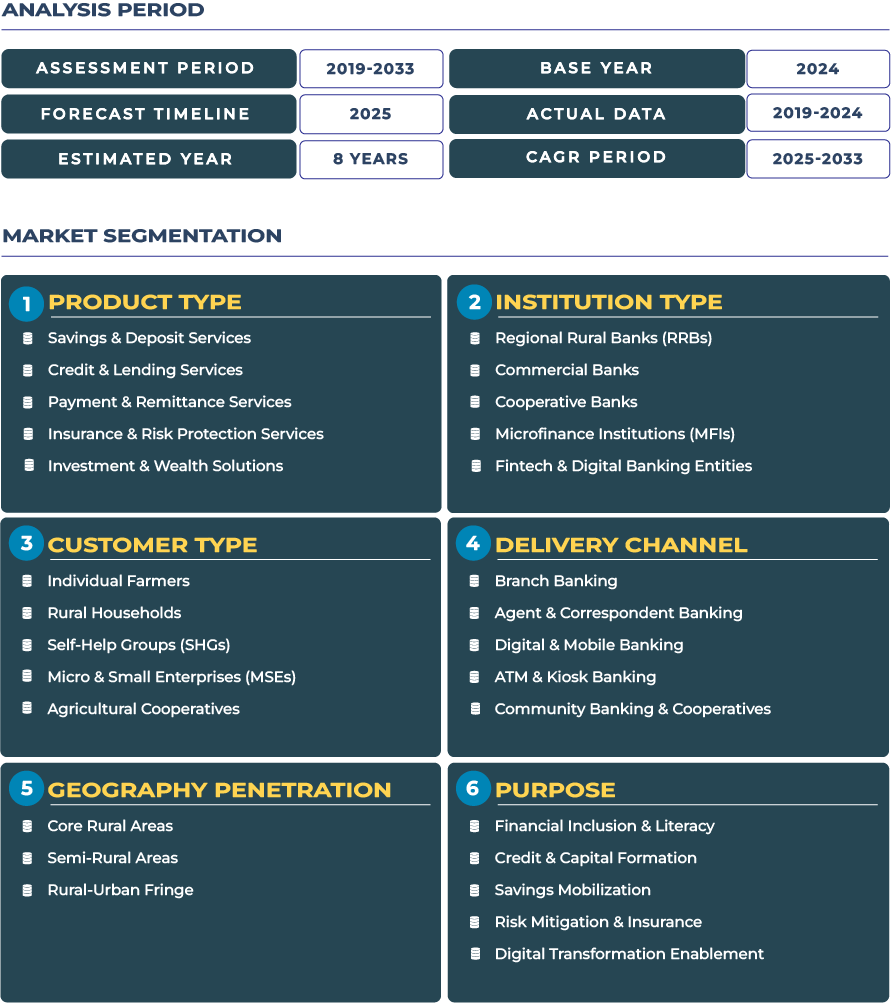Nigeria Rural Banking Market Outlook: Community-Led Finance Powering Inclusive Growth
In Nigeria, the rural banking ecosystem is undergoing a transformative shift, propelled by community-driven financial inclusion and the rapid adoption of mobile money solutions. The foundation of rural finance in the country is built on traditional Village Savings and Loan Associations (VSLAs) that foster trust, group accountability, and local liquidity. Combined with digital financial services and telco-led innovations, these networks have become the cornerstone of modern rural banking models. The Central Bank of Nigeria (CBN) has been instrumental in supporting this shift through financial inclusion frameworks and microfinance policies designed to empower rural populations and smallholder farmers.
Note:* The market size refers to the total fees/revenue generated by banks through various services.
Nigeria Rural Banking Market Outlook: How Community-Driven Inclusion Is Reshaping Nigeria’s Rural Finance Future
The Nigeria rural banking market is projected to grow from USD 11.1 billion in 2025 to USD 20.2 billion by 2033, reflecting a robust CAGR of 7.8% during the forecast period. This growth is rooted in the synergy between informal savings groups, digital banking ecosystems, and government-backed inclusion strategies. Despite economic headwinds such as currency devaluation and high inflation, the resilience of community-led savings models has positioned Nigeria as one of Africa’s most dynamic rural banking environments.
Increasing integration of mobile-driven payment and remittance services has accelerated this evolution, as rural households gain access to digital wallets and microloans for agriculture, trade, and education. Financial institutions are leveraging value-chain financing for crops like cassava and maize, ensuring that credit is linked to marketable output. Meanwhile, partnerships between telcos and microfinance institutions are enabling cost-efficient last-mile access to credit and insurance, particularly across the North Central and South West regions. These dynamics demonstrate how grassroots financial practices are now being reinforced by formal, technology-backed systems, unlocking new pathways for inclusive rural economic growth.
Growth Drivers: Digital Financial Deepening and Diaspora Remittance Flows Fuel Market Momentum
Several powerful forces are driving the expansion of Nigeria rural banking sector. The most significant is the growing adoption of agent banking and mobile money networks in underserved regions. Telcos and fintech firms such as First Bank of Nigeria and Paga are deploying agent networks that bring formal banking to millions who previously lacked access. These models, combined with the success of VSLAs, have created community trust structures that enhance repayment discipline and financial literacy.
Remittance inflows from Nigeria’s diaspora, exceeding USD 19 billion annually according to the World Bank, are also a critical enabler of rural finance growth. Many rural families receive funds through digital platforms, creating liquidity that supports lending and investment. Additionally, increased adoption of micro-insurance and weather-indexed credit schemes has improved risk management in agricultural lending, enhancing bank confidence in rural borrowers. Collectively, these developments are transforming the perception of rural banking from a social necessity to a commercially viable segment of Nigeria’s financial ecosystem.
Restraints: Currency Volatility and Land Title Weakness Constrain Rural Credit Expansion
Despite this progress, several systemic challenges constrain the full potential of the rural banking industry in Nigeria. Currency instability and persistent inflation continue to erode savings value, making long-term deposits less attractive for low-income households. Moreover, weak property titling frameworks hinder the ability of smallholder farmers to use land as collateral for formal credit. The Central Bank’s microfinance guidelines are helping mitigate this, yet enforcement and institutional capacity gaps remain in certain states.
Security concerns in the North East and Middle Belt regions have also disrupted branch operations and restricted agent movement, reducing financial service penetration in conflict-prone communities. Furthermore, inconsistent fiscal policies and FX fluctuations limit access to affordable capital for rural-focused microfinance institutions, constraining their lending capacity. Addressing these barriers will require coordinated policy interventions that blend fiscal discipline with social protection mechanisms to sustain inclusion gains.
Trends & Opportunities: Agent Banking Expansion and Agri-Finance Innovation Define the New Frontier
The rural banking landscape in Nigeria is being reshaped by powerful digital and community-centered trends. One notable trend is the scaling of agent banking models integrated with telco wallets, bringing near-instant access to remittance, savings, and loan products. Rural agents serve as both financial service providers and trust anchors in their communities, enabling higher transaction volumes and smoother adoption of digital tools. The introduction of biometric verification systems has further strengthened rural identity management, reducing fraud risks.
Emerging opportunities lie in village-savings-linked microloans and value-chain financing for agriculture. For instance, new products are linking group savings to credit limits, ensuring collective responsibility and lower default rates. Agrifinance solutions focused on cassava, rice, and maize value chains are helping farmers secure working capital tied to off-taker contracts, while insurance partnerships protect them from weather-related losses. These models are not only promoting credit access but also enabling export-oriented rural enterprises to integrate with formal banking systems.
Competitive Landscape: Local-Global Collaborations Fuel Nigeria’s Rural Banking Innovation
The Nigerian rural banking sector is increasingly characterized by strategic partnerships between telcos, fintechs, and traditional banks. In April 2025, a Nigerian telco and a microfinance bank launched a mobile-wallet-enabled rural credit product aimed at smallholder maize farmers in Benue and Kaduna states. Similarly, in 2025, leading fintech such as Moniepoint, PalmPay, and Paga, partnered with community savings groups to roll out VSLA-integrated microloan programs across rural areas in Oyo and Niger states. These collaborations exemplify how digital ecosystems are merging with community finance to deepen rural credit markets.
Institutions such as NIRSAL (Nigeria Incentive-Based Risk Sharing System for Agricultural Lending) and the CBN are playing vital roles in de-risking agricultural finance by providing loan guarantees and policy incentives for rural lending. Meanwhile, banks are offering value-chain-based credit models where repayments are tied to crop sales through verified off-takers. As more fintech firms integrate data-driven credit scoring and mobile-enabled savings tools, competition in Nigeria rural banking sector is likely to intensify, driving innovation and financial inclusion simultaneously.







